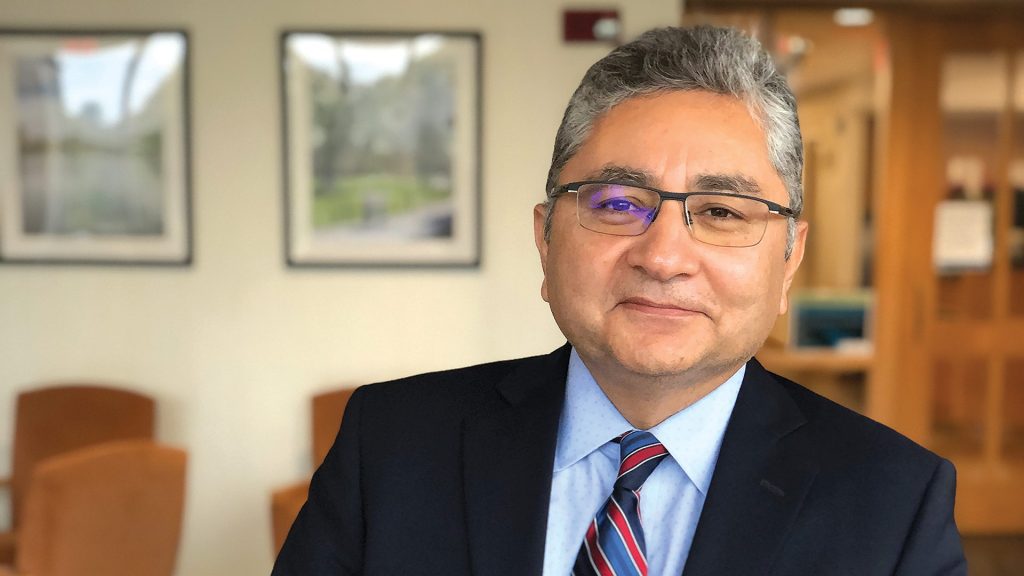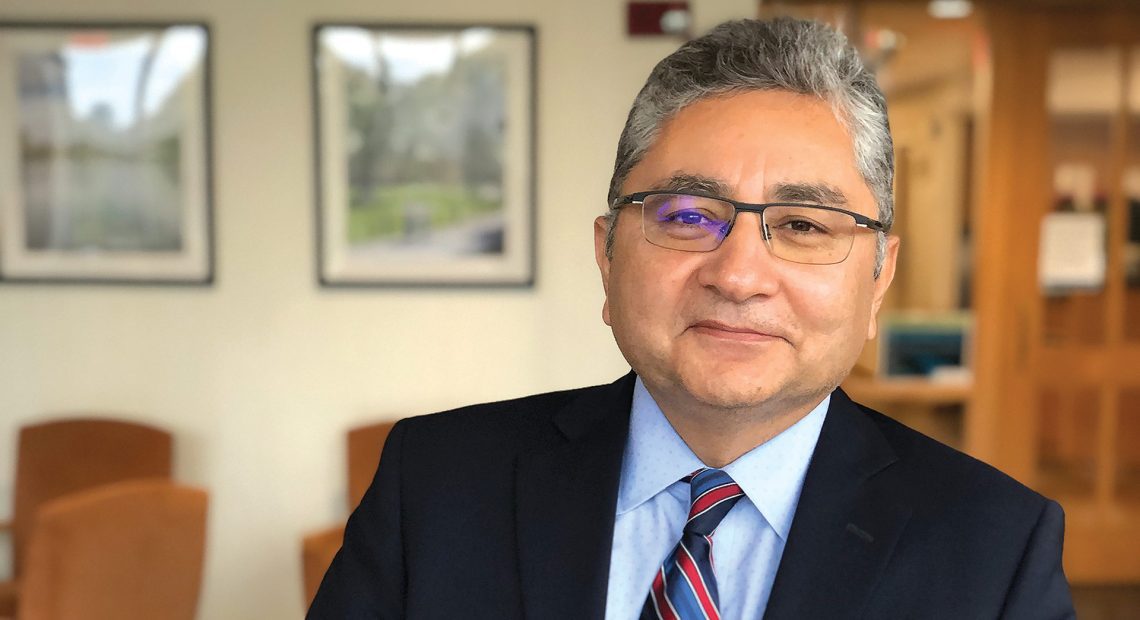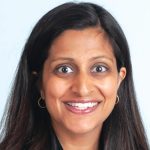Critical Catch

Dr. A. Daniyal Siddiqui says screening is the most important factor in preventing deaths from colorectal cancer.
According to the American Cancer Society, the incidence of young-onset colorectal cancer is rising globally, with about 10% of patients with a new colon-cancer diagnosis, and 25% of patients with a new rectal-cancer diagnosis, being diagnosed under age 50.
Experts are still debating what that means, but there’s broad agreement that people need to start thinking about colonoscopies earlier than ever.
“One should not get to where cancer is diagnosed by symptoms. At that point, it’s a much more advanced stage; you want to get it when the cancer is not causing any symptoms,” said Dr. A. Daniyal Siddiqui, medical director of the Mass General Cancer Center at Cooley Dickinson Hospital and associate professor of Medicine at UMass Chan Medical School.
The statistics bear him out. While treatment of cancer has improved markedly over the decades, so has awareness of the importance of catching it at the earliest stages. In 1975, Siddiqui said, the five-year survival rate for colorectal cancer, across all stages, was 40% to 45%; today, it’s close to 70%.
And the increased incidence in younger people has caused the oncology community to further rethink screening recommendations, pushing them even younger.
The good news, Siddiqui noted, is that colorectal cancer (around 70% of which is colon cancer, 30% rectal) has been declining since the 1980s and declining even faster — between 1% and 1.8% a year — since 2009.
But at the same time, there has been an increase in incidence for younger people. In 1995, 11% of all colorectal cancer diagnoses were in patients 54 or younger; in 2019, it was 20%. For that reason, doctors now recommend starting screening at age 45, instead of the long-recognized guideline of age 50.
Siddiqui says wider adherence to screening recommendations has been impactful over the decades. “If cancers are picked up in the earliest stages, they’re more curable. So the death rate has been going down regardless of age because of better screenings. But the important thing is that incidence is increasing 1% to 1.5% per year in people under age 50. That’s why we should start screening at age 45.”
“One should not get to where cancer is diagnosed by symptoms. At that point, it’s a much more advanced stage; you want to get it when the cancer is not causing any symptoms.”
Why is a colonoscopy so critical? The answer begins with how the disease develops.
Colorectal cancer involves malignant cells that grow in the colon or the rectum, explained Dr. Aparna Parikh, medical director for the Center for Young Adult Colorectal Cancer at the Mass General Cancer Center. Often, colorectal cancers start as polyps, which are non-cancerous, but can turn into cancer over time.
According to the American Cancer Society, when a polyp — a non-cancerous growth in the lining of the colon or rectum — progresses to cancer, it usually grows into the wall of the colon or rectum, where it may invade blood or lymph vessels.
The extent to which cancer has spread at the time of diagnosis is described as its stage. The stages are described as localized (grown into the wall of the colon or rectum but not into nearby tissues), regional (spread through the wall of the colon or rectum and invading nearby tissues or lymph nodes), and distant (spread to other parts of the body, such as the liver or lung).
“Early on, when a polyp is benign, before it becomes cancer, at that point you’re talking a 100% cure,” Siddiqui said. “When you’re in stage 1, localized to the colon or rectum, you’re talking a 90% cure. The rate changes to 70% when the cancer has moved to local lymph nodes.”
And by later stages, the outlook is even worse. In fact, while it’s the fourth-most-common cancer after breast, prostate, and lung cancers, he noted, colorectal cancer is the second-leading cause of cancer-related deaths in the U.S. So it can be critical to undergo regular colonoscopies after 45 — typically once every 10 years.
“There are other screening options, including stool-based tests, but it is important to talk to your primary-care doctor about the advantages and disadvantages of different types of screenings,” Parikh said.
That said, “it’s important to note that these other screening methods are only for patients without symptoms. If you are having any symptoms, it’s important to get a colonoscopy.”
Determining the Risk
Siddiqui stressed that the new age recommendations apply only to average-risk individuals. The higher-risk group includes those with a personal history of colorectal cancer or polyp removal, family history of the disease, a history of seed radiation to the abdomen, or personal or family history of endocrine syndromes or inflammatory bowel diseases like colitis or Crohn’s.
Dr. Aparna Parikh
“To help reduce your risk of getting colorectal cancer, eat healthy foods, including plenty of vegetables, fruits, and whole grains. Exercise regularly, limit or avoid alcohol, and maintain a healthy weight. Finally, quit smoking, or better yet, don’t even start.”
“For those individuals, there’s no black-and-white answer,” he said, explaining that recommendations of when to start screening and how often to go back are determined on a case-by-case basis: what kind of polyp was found, which hereditary factors are present, and so on.
But in general, for the average person, the guidelines start at age 45 and continue until 75, at which time it becomes a more individualized decision between a doctor and patient based on a number of lifestyle factors.
“Screening is the most important thing,” Siddiqui emphasized. “We know now, from prostate cancer and colon cancer and lung cancer, that screening works. That’s the main driving force behind death rates going down.”
The second key factor is improvement in the treatments available after colorectal cancer (CRC) is detected. Options include colorectal surgery, radiation therapy, chemotherapy, targeted therapy, immunotherapy, and access to clinical trials, Parikh noted, adding that “colorectal cancer is largely preventable and, in most cases, curable, especially if it’s detected early.”
As far as prevention strategies are concerned, some risk factors are more easily altered than others. The American Cancer Society reports that 55% of all CRCs are attributable to lifestyle factors, such as an unhealthy diet, insufficient physical activity, high alcohol consumption, and smoking.
“People have been more aware of risk factors of various cancers, and if they’re proactive in terms of reducing them through lifestyle changes, that’s the important thing,” Siddiqui said. “Age is an important risk factor, and so is family history. You can’t change those, but you can change your diet. If you’re obese, you can modify that. If you’re a smoker, you can quit smoking.”
Physical activity is an important factor as well, he added. “We know that from multiple studies with thousands of patients. I’m not saying you should start running a marathon, but simply a 25- to 30-minute walk, three to five times a week, significantly reduces the risk of colon cancer, or any kind of cancer.”
However, the strongest risk factor is a family history of the disease; people with a first-degree relative (parent, sibling, or child) who has been diagnosed with CRC have two to four times the risk of developing the disease compared to people without this family history, with a higher risk when diagnosis is before age 50 and when multiple relatives are affected, the American Cancer Society reports.
Meanwhile, up to 30% of people diagnosed with colorectal cancer have a family history of the disease, which is why these individuals should begin screening early, the organization notes. Young people with a family history should have a conversation with their healthcare provider about when to start screening.
“Everyone should know their family history, and not just colon cancer, but any cancer, especially at a young age,” Siddiqui said. “And that should be brought to a doctor’s attention because that may change the screening guidelines about when to start and how frequently.”
Changes for the Better
Dr. Xavier Lor, medical director of the Colorectal Cancer Prevention Program at Yale Cancer Center and Smilow Cancer Hospital, said recently that certain lifestyle habits associated with colorectal cancer (CRC) aren’t by themselves causing the worrisome trend of higher incidence in younger people.
“Some factors have been identified, and these increase risk, especially at older ages. Obesity, sedentary lifestyle, the western diet, and high sugar intake would only explain a fraction of these cases,” he noted.
“Genetic syndromes are also more commonly the cause for younger CRC patients than older ones, but these remain quite stable over the years and can’t explain a sudden raise in cases as we have seen in the last two decades,” he added. “It will likely boil down to environmental and dietary factors that we have not quite identified yet to explain many of these cases.”
Even absent the cancer risk, there’s nothing wrong with some healthy habits, however.
“To help reduce your risk of getting colorectal cancer, eat healthy foods, including plenty of vegetables, fruits, and whole grains,” Parikh said. “Exercise regularly, limit or avoid alcohol, and maintain a healthy weight. Finally, quit smoking, or better yet, don’t even start.”
When a CRC does develop, the symptoms can vary, she noted.
“Different people may have different symptoms of colorectal cancer, and some people may not have any signs or symptoms at all,” she said, adding that symptoms may include abdominal discomfort or cramping; bleeding from the rectum or finding blood in one’s stool; changes in how the stool looks or frequency of bowel movement; diarrhea, constipation, or increased gas; or unexplained weight loss.
“It is important to remember that these symptoms can be attributed to things that are not related to colorectal cancer,” she added, so it’s important to consult a primary-care doctor with any concerns.
But, as Siddiqui noted up top, the key is catching problems before symptoms arise at all.
“Colonoscopies can detect cancer before you have symptoms or have advanced disease. Early detection is critical,” Parikh said. “But it’s important to advocate for your own health and well-being if you have any concerning symptoms.”








